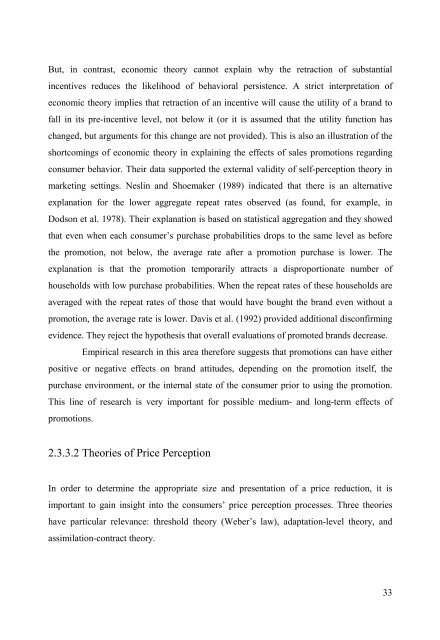Analysis of Sales Promotion Effects on Household Purchase Behavior
Analysis of Sales Promotion Effects on Household Purchase Behavior
Analysis of Sales Promotion Effects on Household Purchase Behavior
You also want an ePaper? Increase the reach of your titles
YUMPU automatically turns print PDFs into web optimized ePapers that Google loves.
But, in c<strong>on</strong>trast, ec<strong>on</strong>omic theory cannot explain why the retracti<strong>on</strong> <str<strong>on</strong>g>of</str<strong>on</strong>g> substantial<br />
incentives reduces the likelihood <str<strong>on</strong>g>of</str<strong>on</strong>g> behavioral persistence. A strict interpretati<strong>on</strong> <str<strong>on</strong>g>of</str<strong>on</strong>g><br />
ec<strong>on</strong>omic theory implies that retracti<strong>on</strong> <str<strong>on</strong>g>of</str<strong>on</strong>g> an incentive will cause the utility <str<strong>on</strong>g>of</str<strong>on</strong>g> a brand to<br />
fall in its pre-incentive level, not below it (or it is assumed that the utility functi<strong>on</strong> has<br />
changed, but arguments for this change are not provided). This is also an illustrati<strong>on</strong> <str<strong>on</strong>g>of</str<strong>on</strong>g> the<br />
shortcomings <str<strong>on</strong>g>of</str<strong>on</strong>g> ec<strong>on</strong>omic theory in explaining the effects <str<strong>on</strong>g>of</str<strong>on</strong>g> sales promoti<strong>on</strong>s regarding<br />
c<strong>on</strong>sumer behavior. Their data supported the external validity <str<strong>on</strong>g>of</str<strong>on</strong>g> self-percepti<strong>on</strong> theory in<br />
marketing settings. Neslin and Shoemaker (1989) indicated that there is an alternative<br />
explanati<strong>on</strong> for the lower aggregate repeat rates observed (as found, for example, in<br />
Dods<strong>on</strong> et al. 1978). Their explanati<strong>on</strong> is based <strong>on</strong> statistical aggregati<strong>on</strong> and they showed<br />
that even when each c<strong>on</strong>sumer’s purchase probabilities drops to the same level as before<br />
the promoti<strong>on</strong>, not below, the average rate after a promoti<strong>on</strong> purchase is lower. The<br />
explanati<strong>on</strong> is that the promoti<strong>on</strong> temporarily attracts a disproporti<strong>on</strong>ate number <str<strong>on</strong>g>of</str<strong>on</strong>g><br />
households with low purchase probabilities. When the repeat rates <str<strong>on</strong>g>of</str<strong>on</strong>g> these households are<br />
averaged with the repeat rates <str<strong>on</strong>g>of</str<strong>on</strong>g> those that would have bought the brand even without a<br />
promoti<strong>on</strong>, the average rate is lower. Davis et al. (1992) provided additi<strong>on</strong>al disc<strong>on</strong>firming<br />
evidence. They reject the hypothesis that overall evaluati<strong>on</strong>s <str<strong>on</strong>g>of</str<strong>on</strong>g> promoted brands decrease.<br />
Empirical research in this area therefore suggests that promoti<strong>on</strong>s can have either<br />
positive or negative effects <strong>on</strong> brand attitudes, depending <strong>on</strong> the promoti<strong>on</strong> itself, the<br />
purchase envir<strong>on</strong>ment, or the internal state <str<strong>on</strong>g>of</str<strong>on</strong>g> the c<strong>on</strong>sumer prior to using the promoti<strong>on</strong>.<br />
This line <str<strong>on</strong>g>of</str<strong>on</strong>g> research is very important for possible medium- and l<strong>on</strong>g-term effects <str<strong>on</strong>g>of</str<strong>on</strong>g><br />
promoti<strong>on</strong>s.<br />
2.3.3.2 Theories <str<strong>on</strong>g>of</str<strong>on</strong>g> Price Percepti<strong>on</strong><br />
In order to determine the appropriate size and presentati<strong>on</strong> <str<strong>on</strong>g>of</str<strong>on</strong>g> a price reducti<strong>on</strong>, it is<br />
important to gain insight into the c<strong>on</strong>sumers’ price percepti<strong>on</strong> processes. Three theories<br />
have particular relevance: threshold theory (Weber’s law), adaptati<strong>on</strong>-level theory, and<br />
assimilati<strong>on</strong>-c<strong>on</strong>tract theory.<br />
33

















